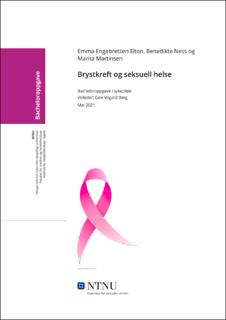| dc.contributor.advisor | Berg, Geir Vegard | |
| dc.contributor.author | Elton, Emma Engebretsen | |
| dc.contributor.author | Ness, Benedikte | |
| dc.contributor.author | Martinsen, Marita | |
| dc.date.accessioned | 2021-09-24T19:52:22Z | |
| dc.date.available | 2021-09-24T19:52:22Z | |
| dc.date.issued | 2021 | |
| dc.identifier | no.ntnu:inspera:77258684:81467771 | |
| dc.identifier.uri | https://hdl.handle.net/11250/2782386 | |
| dc.description.abstract | Tittel: “Hvordan kan sykepleier tilrettelegge for god kommunikasjon rundt seksuell helse hos kvinnelige pasienter etter endt kurativ behandling for cancer mammae?”
Dato: 21.05.21
Forfattere: Emma Engebretsen Elton, Benedikte Ness og Marita Martinsen
Veileder: Geir Vegard Berg
Stikkord/nøkkelord: Seksuell helse, brystkreft, cancer mammae, kommunikasjon, PLISSIT
Antall sider/ord: 37/9999
Antall vedlegg: 0
Bakgrunn:
Brystkreftbehandling påvirker kroppen til pasientene, noe som kan føre til utfordringer med fysisk funksjon, kroppsbilde og selvfølelse. Dette kan igjen påvirke seksuell funksjon og helse. Sykepleier har et ansvar for å følge opp også dette behovet, men kommunikasjon rundt seksuell helse viser seg å være utfordrende. PLISSIT-modellen er et verktøy som skal hjelpe sykepleier å kommunisere med pasienter om seksuell helse.
Hensikt:
Hensikten med denne litteraturstudien er å belyse viktigheten av og utfordringer knyttet til kommunikasjon rundt seksuell helse, og hvordan sykepleier kan tilrettelegge for dette. Vårt fokus er kvinnelige pasienter som har gjennomgått kurativ behandling for cancer mammae.
Metode:
Vi har skrevet en litteraturstudie, og har benyttet oss av både kvantitative og kvalitative forskningsartikler. Gjennom strukturerte søk har vi kommet frem til seks artikler vi har valgt å bruke. Interaksjonsteorien til Joyce Travelbee legger grunnlaget for den sykepleieteoretiske delen av oppgaven.
Resultat:
Seksuell helse blir underkommunisert mellom helsepersonell og brystkreftoverlevende. Pasientene tar sjelden eller aldri opp temaet, til tross for at de opplever problemer knyttet til dette. Tabu og intimgrenser er grunner til dette. De trenger at sykepleier tar initiativ, noe sykepleier syns er utfordrende. Årsakene til dette er at temaet er intimt, mangel på kunnskap, utrygghet og mangel på tid og ressurser. Seksuell helse blir ikke prioritert av fastleger, og det kan da være vanskelig for sykepleier å ta seg tid. PLISSIT-modellen er et av verktøyene som har vist god effekt.
Konklusjon:
Økt kunnskap hos sykepleier kan være med å øke både deres trygghet, men også pasienten og dens eventuelle partneres trygghet og villighet til å kommunisere om seksuell helse. Relasjonsbygging, kompetanseheving og ufarliggjøring av temaet er avgjørende for å skape en trygg plattform for pasienter og deres eventuelle partnere. Økt fokus på dette fremover vil gi en mer helhetlig behandling og oppfølging av brystkreftpasienter og eventuelt deres partnere. | |
| dc.description.abstract | Title: “How can nurses facilitate great communication among sexual health with female patients that have been through curative treatment for cancer mammae?”
Date: 21.05.21
Authors: Emma Engebretsen Elton, Benedikte Ness and Marita Martinsen
Supervisor: Geir Vegard Berg
Keywords: Sexual health, breast cancer, cancer mammae, communication, PLISSIT
Number of pages/words: 37/9999
Number of appendix: 0
Background:
Breast cancer treatment changes the patients bodies, which can lead to challenges with physical function, body image and self-esteem. This can again affect sexual function and health. Nurses have the responsibility to follow up on this need, but communication among sexual health is proving to be challenging. The PLISSIT-model is a tool that could help nurses communicate with patients about sexual health.
Objectives:
The purpose of this study is to shed light on the importance of and challenges linked to communication around sexual health, and how nurses can facilitate this. Our focus is on female patients that have been through curative treatment for cancer mammae.
Method:
We have written a literature study. We used both quantitative and qualitative research articles. We picked six articles for this study, which we found through structured searches. As a ground theory of our study, we used Travelbees interaction theory.
Results:
Sexual health is under-communicated between health care workers and breast cancer survivors. Patients rarely initiate conversations about the topic on their own, even though they experience challenges linked to it. The reason behind this is taboo and intimate boundaries. They need nurses to take initiative, which nurses experience as challenging. This is because the topic is intimate, lack of knowledge, insecurity, and lack of time and resources. Sexual health is not a priority for the general practitioner, and that makes it challenging for nurses to make time for it. The PLISSIT-model is one of the tools that works great.
Conclusion:
Increased knowledge among nurses can contribute to both increase their own security, but also the patients and possibly their partners security and willingness to communicate about sexual health. Relationship building, increased knowledge and making the topic harmless is crucial to be able to build a safe platform for patients and possibly their partner’s. Increased focus on this in the future will contribute to more holistic treatment and follow-up of breast cancer patients and possibly their partners. | |
| dc.language | nob | |
| dc.publisher | NTNU | |
| dc.title | “Hvordan kan sykepleier tilrettelegge for god kommunikasjon rundt seksuell helse hos kvinnelige pasienter etter endt kurativ behandling for cancer mammae?” | |
| dc.type | Bachelor thesis | |
